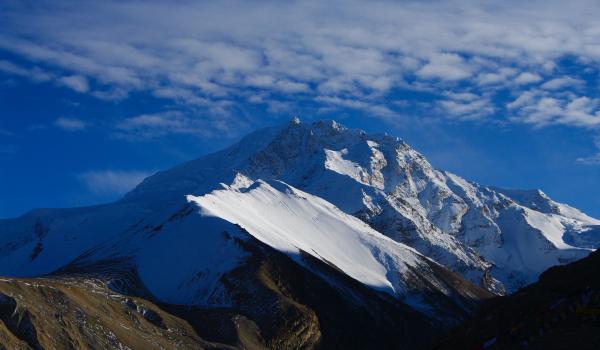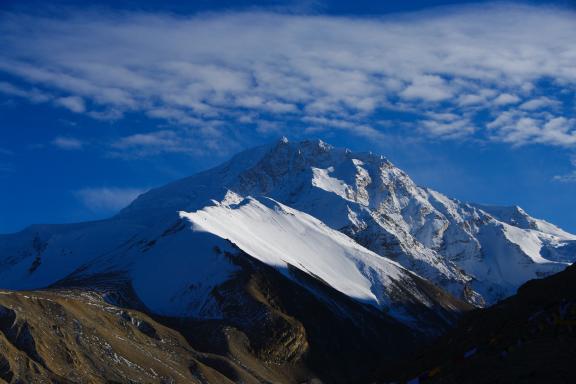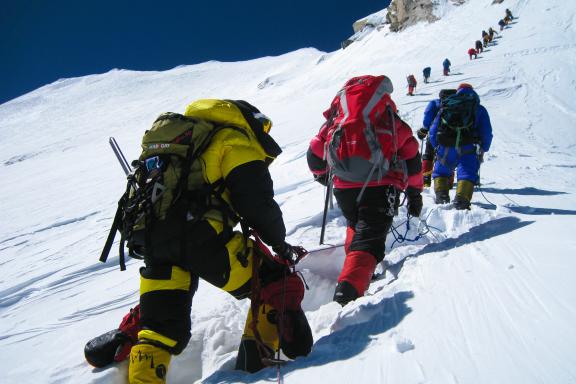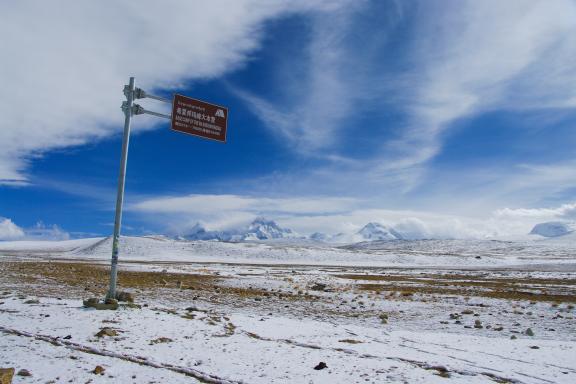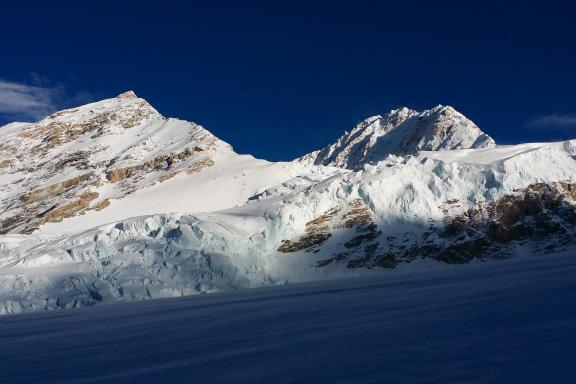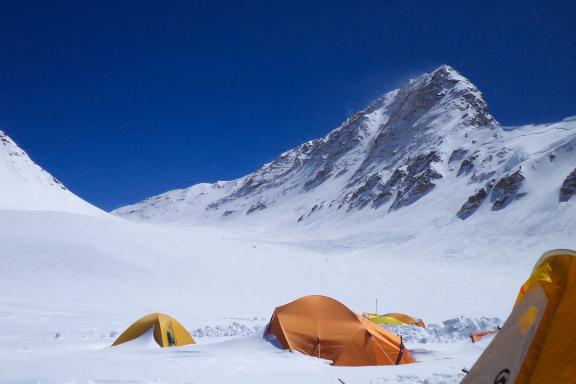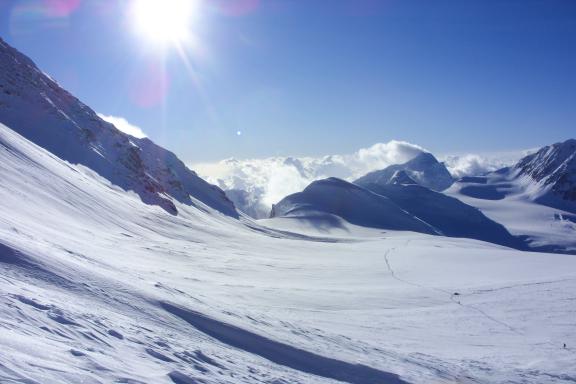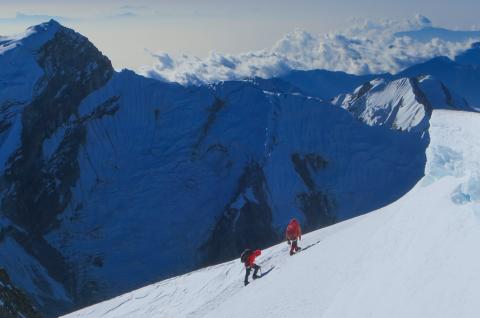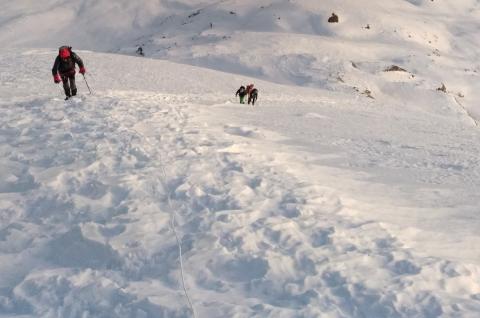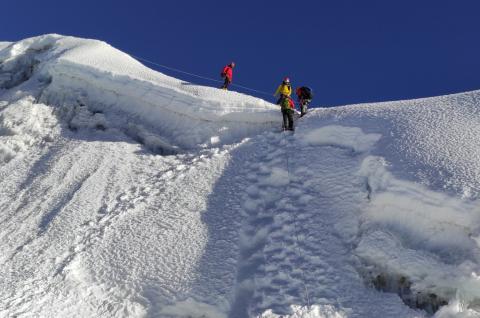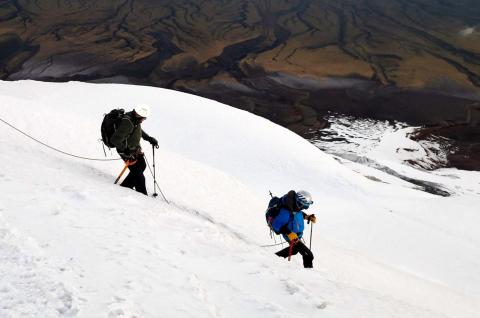A safe and accessible 8000er
Highlights
- Ratio of 1 sherpa to 1 participant
- An accessible 8000 with no objective danger
- Ascent with or without oxygen supply
- Experienced expedition leader
- Special care given to high-altitude food
- H24 personalized weather forecast services and medical hotline
- Preparation course, live expedition coverage
- Guaranteed departure from the first participant
The Shishapangma (8013 meters) is the only summit over 8000 meters entirely located in Tibet and the first peak to exceed the fateful bar of 8000 meters. Its isolation in the middle of communist China earned it the last climb, on May 2, 1964, by a Tibeto-Chinese team. Westerners had to wait until 1978 to set off on its slopes. The north face and the northwest spur do not present any particular difficulty up to the central summit (8013 m) reached by the first climbers. A tapered and delicate ridge connects the central summit and the eastern summit (8027 m), the true summit of the mountain. It is an excellent choice for a first adventure in rare oxygen. Most expeditions stop at the central peak at 8013 meters. For very seasoned mountaineers, we offer the option of reaching the main summit at 8027 meters.
Overview
Expeditions Unlimited offers you an expedition to reach the summit of Mount Shishapangma (Xixabangma for Tibetans, Gosainthan for Nepalese).
Your journey begins in Kathmandu. Once consular and administrative formalities have been completed, a sumptuous flight over the Himalayan range takes you to Lhasa. A day's visit to the Potala is a must. An excellent drive then takes you to the holy city of Shigatse, and on to Tingri. After a few hours' rest to give your body time to acclimatize, you continue first by road, then on a chaotic track to reach the Chinese base camp, the end of the trail.
Two short days of trekking (acclimatization required) on the Tibetan plateau, offering exceptional views of the peaks. At base camp, we allow two more days for acclimatization and the unavoidable religious ceremony, the Puja, which is a prerequisite for any of our Sherpas to set off up the mountain.
This is followed by easy progress to Camp 1. The slopes rise and the route winds its way between crevasses to Camp 2. Steeper slopes lead to Camp 3. A long spur with a few short rocky passages leads to the central summit at 8013 meters. If conditions and your technical level permit, you can embark on the aerial traverse to the real summit: 8027 meters. But that's another adventure, and one that very few ever attempt!
The return journey takes you to western Tibet and the town of Gyirong. You then cross the Himalayas on the new route linking the Tibetan plateau with Langtang (Nepal) and, further on, Kathmandu.
Climbing an 8000er is an undertaking not to be underestimated. To have a real chance of success, it is best to arrive with solid experience of the mountain environment and its conditions. Being able to ascend and descend independently on fixed ropes, and knowing how to move almost single-handedly in complete safety between camps – these are the prerequisites for a successful ascent.
Besides, in the rarefied atmosphere of high altitude and temperatures of –15 to –30°C, even the smallest routine requires a great deal of effort. Excellent physical condition and preparation increase the chances of success.
Expeditions Unlimited provides experienced teams, one high-altitude sherpa per participant, a comfortable base camp and appropriate food. 24 days on the mountain means everyone can find their own rhythm.
Our philosophy is to provide you with all the logistics you need to reach the summit. Oxygen is available as an optional extra, but you are free to make your own ethical choices.
Shishapangma/Cho Oyu combination: the proximity of these two 8000 summits of similar difficulty could justify a double attempt. Once acclimatized on one of the two summits, it would be easy to reach the second to complete the ascent. Unfortunately, to date, the very strict regulations put in place by the Chinese authorities imply two permits and two very distinct ascents.
Follow the animated itinerary of the Shishapangma ascent as if you were there.
MOUNTAINEERS' WORDS
These words of mountaineers, collected for the ascent of Everest, apply perfectly to our ascent of Shishapangma.
“So what is it that makes this summit so fascinating to all mountaineers?... It is the highest mountain in the world... The many expeditions and the men who have conquered it have not succeeded in making it smaller. The altitude remains.“ - Reinhold Messner
“We didn't have to wait for the ultimate vision. Above the fog, Everest was still before us...: motionless as Keats star in its solitary splendor, and so high in the night! Eternal watchman of the shadows, the Mount seemed to intoxicate the world with its radiance.” - George Leigh Mallory
“Suddenly, it occurred to me that the ridge in front of us, instead of continuing to rise, was falling sharply; much lower down, I could see the North Col and the Rongbuck Glacier; in the foreground, a narrow snow ridge climbed towards a snowy summit; a few more ice axe strokes in the hardened snow... and we were at the summit. It was 11:30 a.m.” - Edmund Hillary May 29, 1953.
COLLECTIVE ADVENTURE
Our expedition will be a collective adventure, a crossroads of motivations and energies, a meeting of the capacities of an organization and motivated mountaineers. Two parallel challenges will have to be met:
- for the participant: to be at the top of his physical, technical and mental level when need be;
- for the organizer: to provide impeccable logistics enabling access to the high altitude camps under optimum conditions. Beyond that, it is up to the participants to make their own way up the summit ridge led by the guide and sherpas.
The main objective of this expedition is to experience an adventure that requires total commitment, both physical and moral, acting with lucidity and humility in a hostile natural environment that forgives no imprudence or temerity at the risk of death. It is this testimony that must be wisely recounted.
Good observance of all safety rules is essential, as is good physical and psychological preparation, a warm and supportive environment, total serenity, a little tactics and then, if the weather is kind and luck is on our side, we will be able to count down the magic minutes at the summit when effort ceases and nothingness fills the space and instills itself within us.
All parties agree that giving up does not constitute failure. Returning can also be a victory over oneself. Any preparation, even the most meticulous, any will, even the most tenacious, can be defeated by the adversity of natural environments whose strength is exponentially stronger than the finest human intelligence. Let the gods bless us and allow us to tread the summit.
OUR MOTTO IS: DARE TO CLIMB, KNOW HOW TO DESCEND
VERY HIGH ALTITUDE
Advice from Hubert Giot, mountain guide. He has taken part in several expeditions to 8000 meters and climbed Everest without oxygen.
It is not easy to establish rules, because mountaineers are not equal when it comes to altitude, either physiologically or mentally. Everyone seems to have their own plateau where they get stuck. Extremely tiring, this stage is always painful, but not prohibitive. Once you are past this stage, everything is fine... or not so bad. It is generally at this point that you get a better idea of your ability to adapt. This can happen as early as 6000 meters, or even earlier, during the approach trek.
High altitude also has its own rules, and transgressing them becomes inherently dangerous. There is a fundamental difference between climbing to 8000 meters and descending immediately, and staying there for 12 or 24 hours.
At this altitude, the trouble really starts, and every minute spent up there brings with it an inexorable process of self-destruction. We experience loss of sleep, lack of appetite, apathy and often hallucinatory phenomena.
In short... above 8000 meters, you are consumed. For novices, anything is possible, just remember a few basic rules. The first few days at base camp serve as a thermometer, and by the end of the third day you are often starting to feel good. It is then up to you to decide how to divide up the stages: you can either use the usual camp sites, or those defined by the terrain. As a general rule, when you can sleep at 6500 meters without headaches, you are ready to go higher. However, it is a good idea to make return trips to 7000 or 7500 meters, to test your potential. During these essential phases, it is important to stay well hydrated. Now it is time to spend an often uncomfortable night at around 7500 meters, then attempt the summit at 8000 meters. If the summit is beyond that, we try to sleep at 8000.
As for the rest, you need to be prepared to use your brain (or what is left of it) rather than your muscles, because meters, beyond 8500 meters, are expensive. And if I say brain, it is because it needs to be sufficiently alert to decide when to descend. If it does not, it is certain death. Doing an 8000er in good conditions is tough, but with cold, wind, snow or a barometric depression, it turns into a nightmare.
As a general rule, there are a few precautions to take:
- don't get too cold;
- don't get too hot;
- cover your head;
- stay hydrated, even in bad weather;
- try to have one hot snack a day;
- during the trek, do not walk bare-chested;
- at high altitudes, keep an eye on each other; don't doze off together;
- never descend alone;
- set limits for yourself, and look out for signs such as mirages, falling asleep and total loss of appetite;
- never hesitate to turn back, whatever the pressure;
- and in all cases, accept the fact that the mountains will always be there.
In short, to evolve at high altitude, you need meticulous preparation, adequate acclimatization, constant and mutual verification, intellectual vigilance at all times, and immediate renunciation in the event of weakness, doubt or danger.
Take a look at our web-conference on climbing Everest and Manaslu.
Itinerary
Day 0
EXPEDITION SUMMARY PROGRAM
- Days 1 & 2: International flights to Kathmandu
- Days 3 & 4: Kathmandu, consular formalities and obtaining climbing permit
- Day 5: Flight Kathmandu – Lhasa (3650 m)
- Day 6: Lhasa: day of sightseeing
- Day 7: Drive to Shigatse (3900 m)
- Day 8: Road to Tingri (4350 m)
- Day 9: Rest day in Tingri for acclimatization
- Day 10: Drive to Cho Oyu BC Chinese base camp (4900 m)
- Days 11 & 12: Acclimatization days around base camp
- Day 13: Trek to intermediate camp (5400 m)
- Day 14: Arrival at advanced base camp (5550 m)
- Days 15 & 16: Day at ABC. Buddhist religious ceremony (Puja), preparation of equipment
- Days 17 à 38: Ascent of Shishapangma
- Day 39: Trek back to the end of the trail
- Day 40: Drive to Gyirong (2700 m) Sino-Nepalese border 180 km
- Day 41: Border crossing and road to Kathmandu 240 km
- Day 42: Kathmandu, free day
- Days 43 & 44: International flights
EXPEDITION DETAILED PROGRAM
Day 1: International flight
Day 1
Most flights from Europe allow you to arrive in Kathmandu on the morning of Day 2.
Day 2: Arrival in Kathmandu
Day 2
Arrival of participants. Our teams welcome you and organize your transfer to the hotel. Passports are collected to finalize the Tibet visa application and climbing permit.
Days 3 & 4: Days in Kathmandu
Day 3
Briefing with the expedition leader on the equipment you are taking with you. If necessary, the many mountain gear stores in Thamel can help you complete your equipment. Meanwhile, our local team takes care of all the administrative formalities required to enter Tibet and complete the ascent.
Day 5: Flight Kathmandu – Lhasa
Day 5
Exceptional flight in fine weather. Most of the time, the plane flies eastwards along the entire Himalayan range, overflying and passing between the Everest, Makalu and Kangchenjunga massifs, offering a breathtaking view of the rarely climbed east face of Everest (Kanshung face). Arrival at Lhasa airport, 57 Kilometers from the city, on the south bank of the Yarlung Tsangpo (better known as the Brahmaputra). The scenery on the way to the capital of central Tibet is a wonderful introduction to the days ahead. Due to the already high altitude, we strongly advise you to take it easy. After settling into your hotel, you will discover the lively atmosphere of central Lhasa: the Barkhor (the path encircling the Jokhang temple) where pilgrims from all over Tibet converge, the shopping streets of the Tibetan quarter and the muslim street at the foot of the mosque.
Day 6: Visit to Lhasa
Day 6
Morning visit to the impressive Potala Palace. This 13-storey building is divided into two sections: the White Palace, once the seat of government and winter residence of the Dalai Lamas, and the Red Palace, home to the temples and stupa tombs of the Dalai Lamas. In the afternoon, join the procession of pilgrims to discover the Sangye Tonggu rock carvings on Mount Chakpori. Comprising over five thousand pieces, they form the largest collection of their kind in Tibet. You then visit Norbulinka, the "Jewel Park", once the summer residence of the Dalai Lamas. It is one of the most pleasant places in Lhasa to stroll among trees, ponds, palaces and pavilions.
Day 7: Lhassa – Shigatse drive
Day 7
We drive by private vehicle across the Tibetan highlands to Shigatse, where we spend the night. We take the opportunity to visit the Tashilumpo monastery.
Day 8: Shigatse – Xegar-New-Tingri route
Day 8
The road continues, crossing a faint pass, the Tsuo La (4540 m). Downhill to reach the village of Lhatse on the banks of the Brahmaputra. Just beyond, we pass the junction with Route 219, leading to the distant Mount Kailash. We turn south to reach the highest point of the day: Gyatso La (5259 m). The barrier of the Himalayas, though close at hand, hides behind the hills. Descent to the village of Xegar (New Tingri).
Day 9: New Tingri – Acclimatization day
Day 9
We continue our acclimatization with a rest day in New Tingri. If you are already well acclimatized, you can take a 3-hour hike to the monastery overlooking the town (4600 m).
Day 10: New Tingri – Chinese base camp drive
Day 10
We leave the main road to take the rough and chaotic track leading to the Chinese base camp, some thirty kilometers away. The Cho Oyu appears in all its splendour. Lunch and relaxation in the afternoon.
Days 11 & 12: Acclimatization days at Chinese base camp
Day 11
In preparation for the next two days, to reach the "advanced" base camp (in fact, the real base camp for the ascent), it is best to rest. You can also climb one of the hills bordering the valley, ideally reaching an altitude of 5500 meters before descending. In the afternoon, the Tibetan team distributes the loads among the yaks, always a colorful spectacle.
Days 13 & 14: Trek to Shishapangma advanced base camp
Day 13
The easy walk allows us to appreciate the landscape and completes our acclimatization. We stop at an intermediate camp at 5200 meters. The route could be completed in a single day, but that would not be a good experience for the body. Arrival at base camp early afternoon on the second day. Rest time.
Days 15 & 16: Acclimatization days at Shishapangma base camp
Day 15
Two more days of acclimatization, essential for our organism. Traditional Buddhist ceremony (Puja) with our local team to protect the expedition. Gear preparation.
Days 17 to 38: Ascent of Shishapangma
Day 17
The northwest face and north ridge are the classic ascent route to Shishapangma. Few technical difficulties up to the central summit, a few passages between 35 and 45°. The main difficulty lies in the summit traverse between the central summit (8013 m) and the east summit (8027 m), the real highest point.
The advanced base camp, in fact the real base camp at 5550 meters, is located on the Tibetan plateau, on the lateral moraine of the main glacier.
Three altitude camps are required.
- Camp I (6300 m) – 5 hour trek
Located on a vast snowfield where several tents can be set up. It is used as a supply depot for equipment and food for the upper camps. From the advanced base camp, it takes 3 hours to reach the glacier where crampons are put on. It then takes another 2 hours to reach the camp. Magnificent views of the Tibetan plateau and surrounding peaks.
- Camp 2 (6900 m) – 4 hour trek
Above Camp 1, as the slope rises, you come across the first fixed ropes. These are used to secure the passage through the numerous crevasses. Some passages at 35°/45°. From camp 2, if the weather is clear, you can see the near summit of Langtang Ri, a magnificent pyramid dominating the Langtang Himal (Nepal).
- Camp 3 (7400 m) – 3 hour trek
The steepest part of the route lies between Camps 2 and 3. We climb up 150 meters of fixed ropes on a 35° slope. Camp 3 can accommodate 10-12 tents. A long rest (+/-16 hours) is planned before the final ascent.
- Summit and return to Camp 3 – 12-hour trek
A long day of 10 to 14 hours, depending on conditions. Although the difference in altitude between Camp 3 and the summit is reasonable (630 meters), don't underestimate the steepness of the slopes, nor neglect the altitude. And it all depends on whether you have chosen to stop at the central summit (8013 m), as most expeditions do, or whether you are planning to cross the last ridge to reach the eastern summit (8027 m). The latter part requires perfect conditions. Little or no wind, stabilized snow and good visibility are essential for this aerial ridge. Allow 2 hours 30 to 3 hours of extra effort for the round trip.
Several rotations between the advanced base camp and Camp 2 allow you to acclimatize before climbing to Camp 3 and beginning the ascent to the summit.
The optimum period, once acclimatization has been achieved, is between days 27 and 38, with an expected arrival at the summit around day 34, if the weather window is favourable.
We keep a safe time margin, so as to optimize the chances of summit success in the event of bad weather.Climbing strategy: this is defined according to participants' fitness, weather conditions, the time needed to install the fixed rope between Camp 1 and Camp 2, and the use of oxygen.
If participants take oxygen from 7000 meters, the climb is faster. For those who take little or no oxygen, the acclimatization period is longer.
Day 39: Back to Chinese base camp
Day 39
You will make the return trek with yaks carrying the team's equipment. Then you reach the end of the trail. Our vehicle will be waiting for us. You spend your last night in tents.
Day 40: Drive to Gyirong
Day 40
You take the road to Gyirong, close to the Nepalese border. 30 kilometers of track and 180 kilometers of good road to reach your destination, via the large Paiku Co lake and a pass at 5230 meters. Breathtaking scenery.
Day 41: Gyirong – Kathmandu
Day 41
Drive to the border and back to Kathmandu on the new road to Nepal.
Day42: Day in Kathmandu
Day 42
Contingency day.
Day 43
Day 43
Depending on your flight schedule, you are accompanied to the airport to catch your return flight to Europe.
Day44: Arrival in Europe
Day 44
END OF EXPEDITION
For reasons that cannot be foreseen at this stage, such as unpredictable weather, the physical fitness or lack of fitness of participants or other circumstancess (customs formalities, road conditions, traffic, landslides, force majeure, etc.), your expedition leader may have to adapt the program, if necessary, to ensure the smooth running of your trip. He remains the sole judge and the one who guarantees your safety. Activity times are given as an indication and may vary from one participant to another.
The itinerary for all our expedition programs, or the ascent program for our high-mountain expeditions, are given here as a guide only. They are flexible enough to adapt to weather conditions with a few contingency days. In any case, you should follow the recommendations of your guide, who may suggest that you cancel your expedition due to weather, safety or physical conditions.
It is important to remember that this is a truly unsupported expedition, and that anything can happen. Expeditions Unlimited, your expedition leader, your guide or our local teams can in no way be held responsible.
Any costs incurred as a result of a change in the expedition schedule (extra nights' accommodation, extra flights) will be borne by the participants and not by the organizers. "Contingency days" refer to the expedition in the strict sense of the term (base camp/base camp in the mountains, departure point/exit point on a traverse, etc.).
Any early return of the expedition or of certain members only (early success, abandonment, etc.), generating costs for accommodation, meals, changes to air tickets or other activities not provided for in this program, will be charged in full to the participants.
Trip notes
Guiding
YOUR PRIVATE GUIDE
Key to your success on all our expeditions, we systematically use a ratio of one high altitude sherpa per participant. He accompanies you during the key moments of the ascent and during the summit push. He has taken part in several expeditions to heights of over 8000 meters, successfully leading participants to the summit.. We select him for you. He generally speaks English. He may not be with you all the time during rotations between camps, as his role is also to manage the carrying operations to set up the camps.
A summit bonus is also arranged for your high altitude sherpa, to be paid in cash on site after the ascent. This bonus is due from the moment you leave the last summit camp on your summit push attempt.
Our team of "altitude sherpas" can be made up of several Nepalese ethnic groups, Sherpa of course, but also Tamang, Gurung, Rai, Bothe, etc.
EXPEDITION LEADER
The expedition leader plays an important role in setting up the logistics of the upper camps and implementing the strategy required for success: rotation in the high altitude camps, acclimatization of each participant, study of weather reports to decide on the optimum moment to launch the summit push.
The expedition leader represents Expeditions Unlimited to the group, our partners and local authorities. Mainly based at base camp, he may accompany you to the high altitude camps to oversee the logistics of the expedition. He takes any necessary decisions. His authority is absolute and undeniable. You must respect his decisions, as well as those taken collectively.
From one to five participants, you have a local English-speaking expedition leader who has coordinated numerous expeditions over 8000 meters. He can be shared with other expeditions.
For groups of six or more participants, an experienced French expedition leader is assigned exclusively to your expedition.
LOCAL TEAM
For a project involving the ascent of a major Himalayan peak, our team is particularly well-staffed to deal as effectively as possible with the two key issues of an expedition: technical supervision and the carrying of equipment (food, collective and personal equipment). This is an important issue, as it directly affects the success of both parties. As a result of more than 10 years of joint reflection and work, our operation is fully optimized and the tasks entrusted to each person determine their own status.
We will have a local team with yaks to carry the equipment: 40 kg maximum, so make sure this weight is consistent with the equipment list from base camp to Advanced Base Camp.
A kitchen staff will be present at base camp.
There is a team of sherpas who help us set up base camp with all the equipment and cooking facilities. Beyond that, the team also help us to set up the high altitude camps and with the carrying from base camp.
Each participant is responsible for carrying his or her own personal belongings and high altitude food. Collective equipment is carried by the local team. Our rucksack will weigh between 10 and 12 kg.
And throughout the program, we will rely on other local skills as needed. Finally, we will have access to personalized weather forecast services and a specialized high altitude doctor from Ifremmont (see above).
For unpredictable reasons at this stage, like adverse weather conditions, insufficient physical condition of participants, insufficient competencies of participants related to the intended activities, your guide may decide to adjust the intended program and/or activities. At all times, his decision will be final on all matters likely to affect the safety and well-being of the trip.
Difficulty level
Level rated: extreme
This program is intended for experienced participants, who have a high level athlete's physical and mental condition.
It is rated as "extreme difficulty", given the very high altitude at which you will be climbing. Shishapangma is one of the highest mountains in the world: although the technical difficulties are relative, climbing to the summit is nonetheless a difficult and sometimes even dangerous undertaking. Attempts to reach the summit require a high degree of commitment.
This expedition is therefore designed for experienced mountaineers (with a PD mountaineering grade) who already have a good experience of high altitude. It is essential to be totally autonomous in the mountains, both technically and psychologically. The expedition leader and high-altitude sherpas are first and foremost technical advisors and logistics managers. Under no circumstances can they “pull” a participant to the summit.
Rigorous training is of course necessary, focusing on developing endurance and stamina: running, cycling, swimming, ski touring and, of course, mountain running. This training must be regular and begin at least 6 to 8 months before the start of the expedition.
Preparation will continue to be carried out in constant liaison with our teams. Particular attention will be paid to safety and the management of high-altitude risks.
High altitude is, of course, the major problem we face. The process of oxygen depletion (hypoxia) is at its peak when climbing a peak such as 8000er. Progressive acclimatization is essential to offset this phenomenon as far as possible. During the first few weeks, you should take it easy, avoid violent exertion and go at your own pace. Although “secondary” symptoms, such as migraines and nausea, are virtually unavoidable at first, be careful not to ignore them, as they can trigger an edematous process.
For a relatively long period of time, the body will be subjected to considerable physical exertion in a difficult environment, with the added handicap of high altitude. Serious physical preparation is essential for an expedition of this scale: endurance and stamina must be built up, including in difficult climatic conditions (cold, wind).
It should be noted that we offer climbers the opportunity to attempt a summit ascent without oxygen. Most will take supplementary oxygen from Camp 3 (7600 m). The organization, and in particular the ratio of “1 altitude Sherpa to 1 participant” during the summit push, means that the pace of ascent can be slightly different and more personalized. Don't hesitate to discuss this with us.
Beware of carrying: while collective equipment is transported by high-altitude sherpas, personal belongings must be carried during the ascent; refraining from doing so altogether would be highly detrimental to summit attempts, during which a sizable bag (6 to 8 kg) must be carried, since it will have to contain any oxygen cylinders (4 kg).
On an expedition, participants are confronted with a hostile environment, due to its remoteness, cold, bad weather and discomfort, which can generate stress. Fatigue can also be the cause of mood and interpersonal problems. Everyone must therefore show good humor, tolerance and respect, not only towards other expedition members, but also towards the local team. The group may split into sub-groups according to individual affinities. Keep in mind that it is the core team that prevails and, as always in this type of project, the key to success remains the collective and team spirit.
Therefore, participation in the preparation course, the date of which will be specified later, is mandatory. In addition, mountaineering preparation courses as part of our Adventure School can be a serious asset, both to build confidence and to gain autonomy.
To register for this expedition, you will be asked to provide an expedition/trek/athletic CV. A medical test for hypoxic stress is also compulsory, as is a medical certificate for climbing in the Himalayas. A first 7000 or 8000 is a prerequisite for the license.
For the duration of your expedition, you will benefit free of charge from membership of the H24/7 high-altitude medical service set up with Ifremmont, of which we are a partner. See below. If you have any health problems that you feel could compromise the success of your expedition, please let us know so that we can assess together whether they are compatible with this expedition. And we strongly advise you to have a check-up with your dentist before departure, given the length of the expedition and the significant variations in altitude and pressure.
Finally, we can provide you with a sports coach and/or a mental coach for the months leading up to your expedition, so that you can prepare yourself in the best possible conditions. We have developed remote protocols in this field, just as we have built a hypoxia preparation protocol which we describe later in this document in the chapter devoted to Ifremmont.
In the longer term, we offer refresher and advanced mountaineering courses as part of our Adventure School, as well as expeditions to peaks at 5000, 6000 and 7000 meters, offering you ideal progress towards your dream goal at very high altitude.
Technical difficulty
Mountaineering level: PD like... A little difficult (Peu Difficile in French)
In this program, the use of mountaineering equipment (crampons, harness, ice axe, ropes, etc.) is necessary, and the route tackled may involve minor difficulties, whether it be slightly steeper passages in a glacier run, the height of the wall, the engagement of the run and the continuity of effort. Of course, altitude makes everything more difficult. Steep or more arduous passages are all equipped with fixed ropes, so you need to be comfortable with a jumar clamp in all situations. This climb is aimed at participants with previous mountaineering experience and who have already completed climbs of this level.
This technical rating applies, of course, to normal weather conditions: difficulty can increase in poor conditions, with fresh snow for a rocky route, insufficient or poor-quality ice for a glacier route, etc., and the situation can change radically if the weather is not too bad. Similarly, the situation changes radically, for the same technical level, with altitude, the weight of the rucksack, the lack of equipment on the route, the fatigue associated with the long approach, the particularly hostile environment, etc.
At last, this rating applies to the central / standard summit at 8013 meters. The main summit at 8027 meters is much more engaged, and requires to ascend a knife-edged ridge of 300 meters long and 19 meters in altitude.
Our École de l'Aventure's three- to five-day mountaineering courses are designed for you, and are the perfect way to check your level..,
Meeting point
We meet up in Kathmandu and are welcomed at the airport by our local teams.
Given the diverse origins of the participants on this trip, international outward and return flights are not included in this package. In most cases, we book flights on your behalf to ensure that the whole group arrives at the destination at the same time. We do not charge any fees for these air bookings. Please do not hesitate to contact us. If you book your own tickets, we will advise you on the ideal flight schedule to enable all participants to arrive within a reduced time frame. At the very least, you need tickets that can be modified.
Accommodations
KATHMANDU AND LHASA
In a single room in a 3/4* hotel in Kathmandu and Lhasa.
SHIGATSE, NEW TINGRI AND GYRONG
Single rooms in local hotels, subject to availability.
BASE CAMP
At base camp, we stay in individual tents.
As a base for several weeks, it needs to be as comfortable as possible, to enable us to recover properly on our return from the altitude camps. It should also enable us to cope with periods of bad weather in the best possible conditions. Each participant has his or her own individual tent with a comfortable mattress. A heated mess tent is the main living area. Tables and chairs are permanently installed. We also have a shower tent and a toilet tent (solid waste is disposed of in drums).
HIGH ALTITUDE CAMPS
During the ascent, at the altitude camps, we have an altitude tent for 2 people, and even 3 people at the last camps.
Hygiene & laundry
Toilets: The base camp is equipped with toilets and toilet paper. Make sure you wash your hands with a hydro-alcoholic gel (available from your personal pharmacy) after each use of the toilet. For the higher camps, we recommend that you take a bottle with you to urinate in at night, to avoid having to go outside.
Daily hygiene: a basin with soap and water is available at the entrance of the mess tent. Water for washing hands and face; do not drink.
Showers: hot water available (request from kitchen). Showers should only be taken on sunny days to avoid catching cold!
Laundry: (cold) water and basin to be requested from the kitchen. Bring biodegradable products only.
Meals
KATHMANDU AND LHASA
On arrival in Kathmandu, a welcome dinner is offered on the first evening. Similarly, on your return from the expedition, a farewell meal is provided. In Lhasa, there are many Chinese and Tibetan restaurants to choose from.
SHIGATSE, NEW TINGRI AND GYRONG
Meals at hotels where we stay.
BASE CAMP
All meals are prepared by the kitchen staff using local ingredients, including rice, pasta, lentils, potatoes, vegetables, eggs, a little meat, etc. They are served in a private tent. Hot non-alcoholic beverages such as tea and coffee are provided free of charge. We recommend that you stay hydrated at all times.
HIGH ALTITUDE CAMPS
At altitude, you often have to force yourself to eat. The use of freeze-dried food is almost unavoidable. But such dishes, appetizing in the valley, quickly become a source of disgust in high altitude camps. During the preparation course, we bring a sample of lyophilized dishes for you to taste, to indicate your preferences, which we do our utmost to respect (depending on the stocks available at the time of final purchase). You can also bring along a few of your favorite dishes (if you have any). For your comfort and the pleasure of tasting, we have included a few "delicacies" from France (savoury and sweet).
Each tent has a stove for melting snow (MSR Reactor type) and making water for freeze-dried food and hot drinks. The necessary gas cartridges are supplied.
HYDRATION
Take along tablets (such as Hydroclonazone, Micropur or others) to disinfect the water you put in your water bottle, depending on the source and on the advice of your guide. It is sometimes possible to buy purified water and fill your bottle without having to buy bottled water. You can also buy "mineral" water in the towns (not included in the price), but as you know, it has a poor environmental performance. So we do not recommend it.
Besides, glacier meltwater contains no mineral salts, which is partly compensated for by the soups and other meals you will be eating. But if you only drink tea or coffee made from glacier meltwater, or just water in your water bottles, over a long expedition, youwill hydrate less well, risk gastric problems and, ultimately, deficiencies that will tire the body. To counter this problem, it is a good idea to pack mineral tablets in your luggage at some point, to supplement your water bottle. Two or three tubes of ten tablets are all you need.
Transfers / Transport
Transfers to and from the airport are by minibus. The itinerary is planned by 4x4 or minibus.
Group size
The group is composed of 1 to 10 participants maximum. The number of participants is deliberately limited to allow for greater immersion, to avoid embarrassing our hosts, and to develop freedom and flexibility. However, the maximum number may be exceeded if the last person to register wishes to travel with one or more other people. The services will not be modified, and the conditions of the trip will remain the same.
Equipment
COLLECTIVE EQUIPMENT
All logistical equipment is provided, including individual tents at base camp with mattresses, mess tent, shower tent and toilet tent, as well as all collective and individual cooking equipment. At altitude, tents, stoves with gas cartridges, ropes and anchors.
INDIVIDUAL EQUIPEMENT
Personal equipment is not provided. A full list is given later in this document. It will be refined with us during the preparation course and up to the moment of departure, depending on your questions.
High altitude sleeping bags, full-body down suits and/or good-quality down jackets are expensive items that you may not use frequently. We can rent you this specific equipment for the duration of the expedition. You must then return the equipment cleaned and in the condition in which it was given to you (deposit required). The rental price will be communicated to you on request. The cost of transport remains your responsibility, unless you pick it up at the agency in Lyon.
OXYGEN OR NO OXYGEN
To be on the safe side, high-altitude Sherpas always use oxygen, albeit at a reduced flow rate.
The vast majority of participants in allSishapangma expeditions take oxygen from Camp 3 (7400 m), and for some as early as Camp 2 (6900 m). We therefore include in your package an oxygen supply oxygen from Camp 3, i.e. a cylinder, regulator and oxygen mask for you. The cylinders and are transported to the high altitude camps by the high altitude porters.
If you wish to use additional oxygen before Camp 3, you will need to ask your expedition leader and/or sherpa as soon as possible during your expedition, and additional cylinders will be charged extra. Oxygen cylinders not included in the package must be paid for on site.
Having said that, we are one of the few organizers to allow our participants to attempt the summit without taking supplementary oxygen. Our experience has shown us that this is entirely possible, as the organization and in particular the ratio of "1 altitude sherpa to 1 participant" allows us to ensure slightly different and personalized ascent rhythms. We can also have participants in the same group who use oxygen and others who do not
If you choose to attempt the ascent without using oxygen beyond the last camp, you need to talk to us as soon as possible to fine-tune your acclimatization. Your choice will depend on the agreement of your expedition leader and/or your sherpa, who will assess your fitness during the first few rotations.Please note that if you choose not to use supplemental oxygen for your ascent, no refund will be given. For safety reasons, one oxygen cylinder per participant is provided at Camp 3, whether you use it or not.
SECURITY AND COMMUNICATION
We have a minimum of one Iridium satellite phone for the group, which is used for logistical, weather and safety purposes only. Under certain conditions, participants may make use of it. For private use, please contact us.
The camps will be permanently linked by radio. Expedition leader, participants and high-altitude sherpas will also be able to use them.
The expedition will have a hyperbaric chamber at base camp, and a full pharmacy, though lighter, at the upper camps.
The group will be equipped with a Garmin Inreach beacon, enabling you to communicate freely and without restriction with your friends and family, wherever you may be on the mountain, as well as sending tracking and safety information. It is on this beacon that you will receive weather forecasts and that we will communicate together regularly.
At the same time, we will provide live coverage of the expedition for the general public, including a logbook and photographs, enabling you to share your adventure with your community. To this end, and if the base camp is not equipped with wifi or 4G, you can also use an IridiumGo system to send your photos. These systems are simple to use, but require a few tests before departure, which we will carry out together.
In addition, at the time of writing, all participants are free to bring any systems they have. We just need to be able to declare them to our contacts, so please let us know in advance.
Please note: in order to preserve the serenity of this expedition and the privacy of the participants, we ask you not to communicate with the general public during the expedition. You are, however, free to send information about yourself to your private sphere. By registering for this program, you accept this essential clause to protect the privacy of other participants in a project of this scale, where important issues of image, physical risk and financial considerations (sponsors, etc.) are at stake.
Our commitments to sustainable development
Our commitment to a better planet has been a reality since the beginning of our story but we always need to do more and better. Please find out more about our charter and our commitments in terms of sustainable development. We have drafted our charter and take action through six themes on which we act as concretely as possible, most often with you: social equity and cultural respect, preservation of water, waste management in expedition, protection of biodiversity, raise public awareness on these subjects and finally, the optimization and recovery of CO2 emissions.
Regarding carbon emissions, most of which are due to air travel, we calculated and communicated in 2018 on the carbon footprint of each of our programs, expressed in tonnes of CO2.
These calculations made us aware of the importance of the total carbon emissions generated by our activity. Also, we have committed in 2022 to a carbon reduction that we believe is unprecedented in the tourism industry, aiming to reduce the total emissions of our activity by 5% per year, taking 2019 as the reference year (3,430 tonnes of CO2). This commitment is in line with the trajectory of the Paris climate agreements of 2015, the current benchmark. Thus, in 2030, we commit ourselves not to exceed 2,160 tonnes of C02. Thus, our maximum “carbon” budget for 2024 is 2,950 tonnes and for 2025, this budget will be reduced to 2,800 tonnes. And so on until 2030. To find out more about all of our calculations and our commitments in terms of reducing our carbon emissions.
In addition, since 2019, we have been encouraging you when you book for your journey to contribute with a donation to an independent NGO, among the two we have selected that share the commitments made in our charter. We matched the amount of this donation to this program's carbon footprint. Thus, the journey you are considering generates 4,09 tons of CO2, which corresponds to a 100% donation of €123 for an estimated value today of €30 per tonne of CO2. This donation remains of course optional and you can decide to give between nothing and 100% of this amount. Since 2019, including covid years of 2020 and 2021, we have been able to collect thanks to you nearly €7,000 for these associations.
Please do not hesitate to come back to us with any questions you might have regarding this carbon footprint mechanism, our other sustainable développement commitments or even to share with us your experience through a chat or a mail at contact@secret-planet.com.
Expedition leader
We rely on the most experienced high altitude expedition leaders. They are part of our close community and co-opt each other. They know each other well and respect each other.
For this expedition, the expedition leader has not yet been formally appointed, but should be shortly.
In addition to their exceptional expeditions experience, our expedition leaders have the know-how to optimize the expedition's chances of success, both in terms of group management and in terms of the pace at which the group builds up its strength and progresses in altitude, key elements in this type of expedition.
Departures and pricing
Please find below all dates and prices for this expedition. Prices are quoted "from" and may be adjusted notably according to the number of participants (see trip notes for details). Please note that dates and prices for years beyond 2024, when given, are for guidance only and are subject to change and readjustment to take account of current economic realities.
No date works for me!
I initiate a new datePrice includes
- Flight Kathmandu - Lhasa
- 3/4-star (***) hotel accommodation in Kathmandu and Lhasa with breakfast, double room for five nights
- Hotel accommodation in double room with breakfast in Lhasa, Shigatse, New Tingri and Gyrong
- Welcome dinner on arrival in Kathmandu
- Meals as mentioned in the program
- Guided tour of Lhasa and transfers
- Tibet visa and Shishaspangma climbing permit
- Transport of your personal equipment between Kathmandu and the advanced base camp, based on 40 kg per person
- Equipment required for life at the advanced base camp: fully-equipped kitchen tent, mess tent for meals, toilet tent, shower tent, table and chairs.
- Cook and helpers
- Experienced French mountain guide from 6 participants
- 1 local altitude guide for every 1 participant: he carries food and equipment to the high camps and assists you on the final ascent
- 1oxygen cylinders with mask and regulator per participant for the summit push
- 1 oxygen cylinders with mask and regulator per altitude guide
- Altitude tents, altitude food, stoves and fuel
- Collective equipment required for ascent (fixed ropes, moorings, etc.)
- 1 walkie-talkie for every 1 altitude guide, in connection with base camp and advanced base camp
- Insurance for altitude guides (evacuation, hospitalization, medical expenses, life insurance), for the cook and his helpers, and for the Chinese liaison officer
- Equipment allowance, fees, tent and food for cook and helpers, and for Chinese liaison officer
- 1 satellite telephone at advanced base camp (for rescue purposes only)
- Government environmental taxes and garbage deposit.
- Personalized weather forecast services
- Preparation courses (practical, medical)
- Medical follow-up by Ifremmont during the expedition (see above)
- Live expedition coverage for your community (supply of InReach beacon, IridiumGo and subscriptions, LivExplorer service configuration)
Price does not include
- International return flights Kathmandu
- Hotels and meals mentioned as "not included" in the detailed program
- Personal equipment including individual high altitude gear
- Rental of personal high altitude equipment, subject to availability
- Any additional oxygen cylinder (approx. US$650 to be paid locally)
- Personal satellite phone calls (to be paid locally, approx. US$3/minute)
- Drinks and personal expenses (sightseeing, cabs, souvenirs, dry-cleaning, etc.)
- Travel and expedition insurance (assistance and repatriation)
- Expenses related to the early return of the expedition or of certain members only (early success, abandonment, etc.), generating costs for accommodation, meals, changes to air tickets or other activities not provided for in this program
- Expenses related to a shift in the expedition schedule (extra nights' accommodation and meals, additional airfares)
- US$1,500 summit bonus for your altitude guide, to be paid on site after the ascent
- Tips for local team, 400 US$/participant
- Excess baggage for the Kathmandu/Lhasa flight: on this flight, you are entitled to one checked luggage item weighing 23 kg and one cabin luggage item weighing 7 kg. For each additional kilo, you will be required to pay a local fee of US$7/kilo/journey
- Import permits for electronic equipment regulated in China, in particular satellite telephones (US$500), communications and image equipment (up to US$30,0000 to be paid to CTMA)
- Customs duties on arrival in Népal for specific equipment or other items
Your custom expedition
We put our expertise, our knowledge of the terrain, our creativity, our experience, the quality of our guides and the reliability of our partners at your service to build your custom expedition. We can also personalize an expedition to your wishes as soon as you form a "closed" group, whatever the number of participants.
This means that, unless you authorize us to do otherwise, no outside participants join you, and we can personalize your expedition by adapting it to your own pace, with the program extensions you desire, a higher level of comfort, certain activities, other encounters, etc.
Every expedition of this type is subject to a specific quotation. To get in touch with us now, please fill in the short questionnaire below. One of our experts will get back to you to refine your request and make you a proposal.
